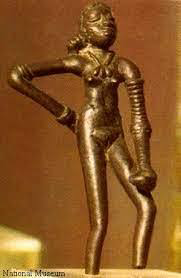 |
Indus vally civilization in women status |
The Indus Valley Civilization, which existed around 3300 to 1300 BCE, provides limited information about the role of women during that era. However, archaeological evidence suggests that women in this civilization had some level of social and economic participation. They likely engaged in various activities, including agriculture, pottery making, and textile production. The presence of female figurines and ornaments indicates that women might have played important roles in art and adornment as well. Keep in mind that our understanding of this ancient civilization is still evolving as new discoveries are made.
सिंधु घाटी सभ्यता में महिलाओं की स्थिति
सिंधु घाटी सभ्यता, जो लगभग 3300 से 1300 ईसा पूर्व तक अस्तित्व में थी, उस काल में महिलाओं की भूमिका के बारे में सीमित जानकारी प्रदान करती है। हालाँकि, पुरातात्विक साक्ष्य बताते हैं कि इस सभ्यता में महिलाओं की सामाजिक और आर्थिक भागीदारी कुछ हद तक थी। संभवतः वे कृषि, मिट्टी के बर्तन बनाने और वस्त्र उत्पादन सहित विभिन्न गतिविधियों में संलग्न थीं। महिला मूर्तियों और आभूषणों की उपस्थिति इस बात का संकेत देती है कि महिलाओं ने कला और श्रृंगार में भी महत्वपूर्ण भूमिकाएँ निभाई होंगी। ध्यान रखें कि इस प्राचीन सभ्यता के बारे में हमारी समझ अभी भी नई खोजों के साथ विकसित हो रही है।In the Indus-Saraswati civilization era, women are believed to have made significant economic and social contributions. While our knowledge is based on archaeological evidence, here are some key aspects of their roles:
ऐसा माना जाता है कि सिंधु-सरस्वती सभ्यता के युग में महिलाओं ने महत्वपूर्ण आर्थिक और सामाजिक योगदान दिया था। हालाँकि हमारा ज्ञान पुरातात्विक साक्ष्यों पर आधारित है, फिर भी उनकी भूमिका के कुछ प्रमुख पहलू इस प्रकार हैं:
Economic Contribution:
आर्थिक योगदान:
Agriculture: Women likely played a role in agriculture, involved in planting, harvesting, and food processing.
Agriculture: Women likely played a role in agriculture, involved in planting, harvesting, and food processing.
Craftsmanship: They were skilled in crafting pottery, textiles, and other artifacts, which were essential for trade and daily life.
Trade: Women may have been involved in trade activities, as indicated by the widespread exchange of goods within the civilization. skilled in crafting pottery, textiles, and other artifacts, which were essential for trade and daily life.
कृषि: महिलाएँ संभवतः कृषि में भूमिका निभाती थीं, रोपण, कटाई और खाद्य प्रसंस्करण में शामिल थीं।
शिल्पकला: वे मिट्टी के बर्तन, वस्त्र और अन्य कलाकृतियाँ बनाने में कुशल थीं, जो व्यापार और दैनिक जीवन के लिए आवश्यक थीं।
व्यापार: जैसा कि सभ्यता के भीतर वस्तुओं के व्यापक आदान-प्रदान से संकेत मिलता है, महिलाएँ व्यापारिक गतिविधियों में शामिल रही होंगी। वे मिट्टी के बर्तन, वस्त्र और अन्य कलाकृतियाँ बनाने में कुशल थीं, जो व्यापार और दैनिक जीवन के लिए आवश्यक थीं।
Social and Cultural Roles:
Social and Cultural Roles:
सामाजिक और सांस्कृतिक भूमिकाएँ:
Religious Significance: Many female figurines, often interpreted as fertility goddesses or symbols of abundance, indicate that women were revered in religious practices. The emphasis on fertility suggests they were central to spiritual and community life.
Family Structure: Women likely held essential roles within family units, contributing to the household economy and social continuity.
धार्मिक महत्व: कई महिला मूर्तियाँ, जिन्हें अक्सर प्रजनन देवी या प्रचुरता का प्रतीक माना जाता है, इस बात का संकेत देती हैं कि धार्मिक प्रथाओं में महिलाओं का सम्मान किया जाता था। प्रजनन क्षमता पर ज़ोर देने से पता चलता है कि वे आध्यात्मिक और सामुदायिक जीवन का केंद्रबिंदु थीं।
पारिवारिक संरचना: महिलाएँ संभवतः पारिवारिक इकाइयों में महत्वपूर्ण भूमिकाएँ निभाती थीं, घरेलू अर्थव्यवस्था और सामाजिक निरंतरता में योगदान देती थीं।
Political and Leadership Roles:
Although direct evidence of women in political roles is scarce, the advanced urban planning and organized trade systems suggest the possibility of gender-inclusive governance or societal balance.
राजनीतिक और नेतृत्वकारी भूमिकाएँ:
हालाँकि राजनीतिक भूमिकाओं में महिलाओं की प्रत्यक्ष उपस्थिति के प्रमाण कम हैं, उन्नत शहरी नियोजन और संगठित व्यापार प्रणालियाँ लैंगिक-समावेशी शासन या सामाजिक संतुलन की संभावना का संकेत देती हैं।
Adornment and Status:
Adornment and Status:
Jewelry, cosmetic items, and elaborate attire discovered in graves indicate that women valued personal adornment and may have had social status markers based on wealth or role in society.
श्रृंगार और प्रतिष्ठा:
कब्रों में मिले आभूषण, सौंदर्य प्रसाधन और विस्तृत परिधान इस बात का संकेत देते हैं कि महिलाएँ व्यक्तिगत श्रृंगार को महत्व देती थीं और संभवतः धन या समाज में उनकी भूमिका के आधार पर उनकी सामाजिक प्रतिष्ठा के चिह्न होते थे।
Education and Knowledge:
Education and Knowledge:
While there is no direct evidence of formal education, the complexity of the society suggests women may have had knowledge in various fields, such as medicine, crafts, and agriculture.
शिक्षा और ज्ञान:
यद्यपि औपचारिक शिक्षा का कोई प्रत्यक्ष प्रमाण नहीं है, फिर भी समाज की जटिलता से पता चलता है कि महिलाओं को चिकित्सा, शिल्प और कृषि जैसे विभिन्न क्षेत्रों का ज्ञान रहा होगा।
Challenges in Interpretation:
Challenges in Interpretation:
The undeciphered Indus script limits precise knowledge about women's roles.
Interpretations rely on material evidence, which can be speculative.
व्याख्या में चुनौतियाँ:
अस्पष्ट सिंधु लिपि महिलाओं की भूमिकाओं के बारे में सटीक ज्ञान को सीमित करती है।
व्याख्याएँ भौतिक साक्ष्यों पर आधारित होती हैं, जो काल्पनिक हो सकते हैं।
In conclusion, women in the Indus Valley Civilization likely played diverse and integral roles, ranging from economic contributions to cultural and religious leadership. The civilization's relatively egalitarian urban structure may reflect a society where women were valued contributors.
In conclusion, women in the Indus Valley Civilization likely played diverse and integral roles, ranging from economic contributions to cultural and religious leadership. The civilization's relatively egalitarian urban structure may reflect a society where women were valued contributors.
निष्कर्षतः, सिंधु घाटी सभ्यता में महिलाओं ने आर्थिक योगदान से लेकर सांस्कृतिक और धार्मिक नेतृत्व तक, विविध और अभिन्न भूमिकाएँ निभाई होंगी। सभ्यता की अपेक्षाकृत समतावादी शहरी संरचना संभवतः एक ऐसे समाज को दर्शाती है जहाँ महिलाएँ मूल्यवान योगदानकर्ता थीं।
Comments
Post a Comment